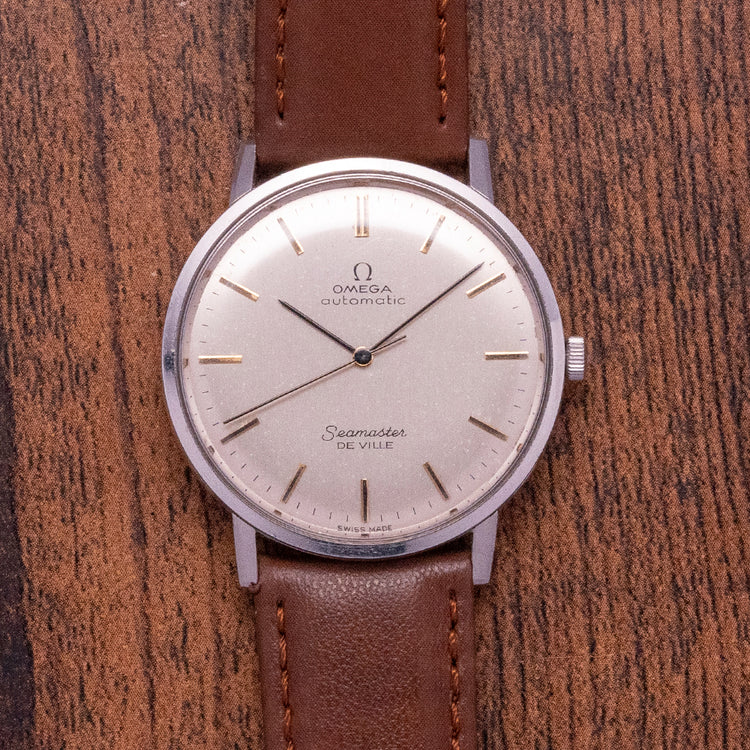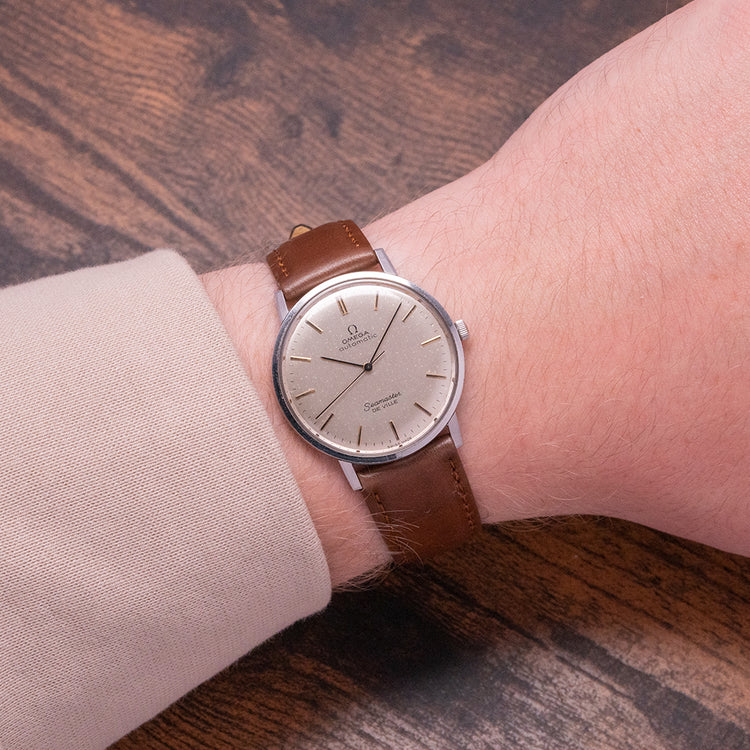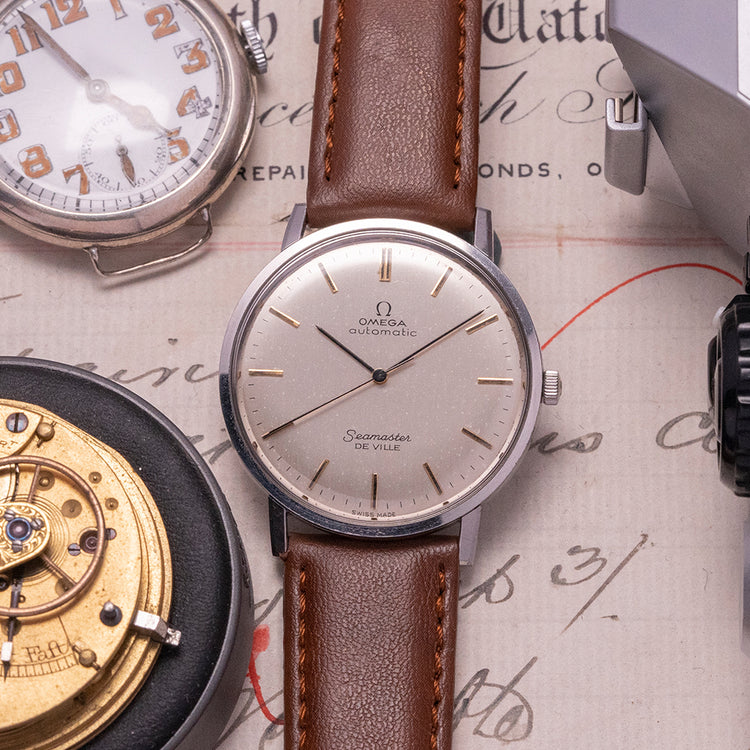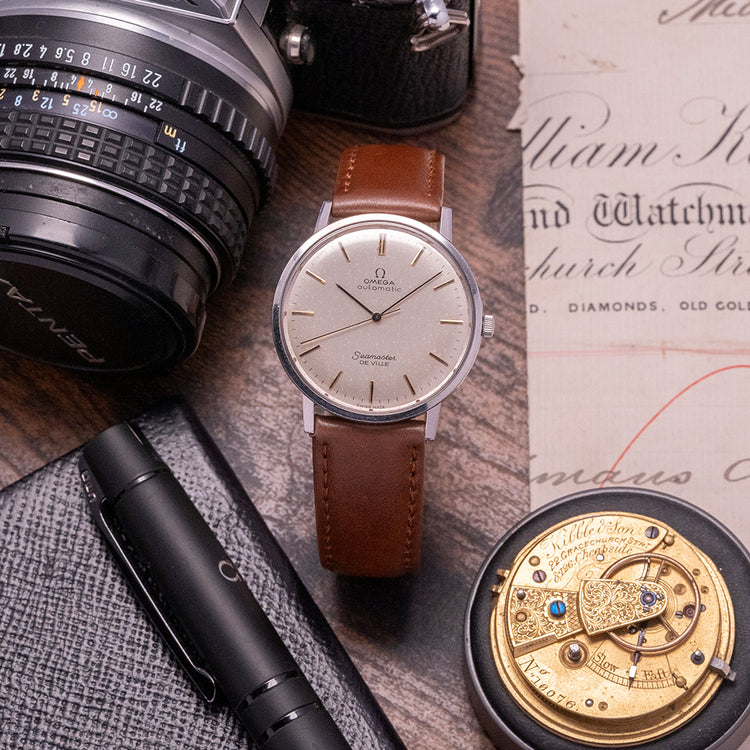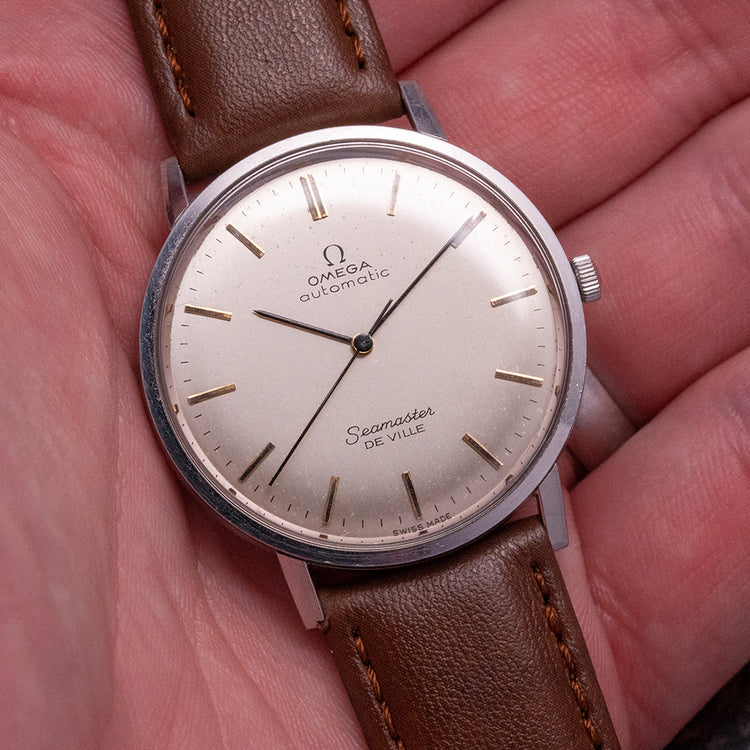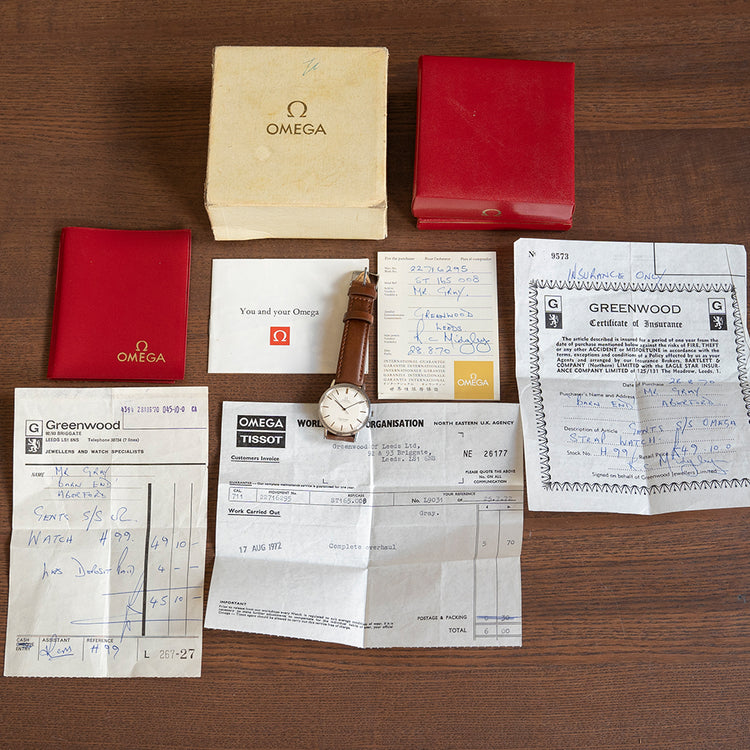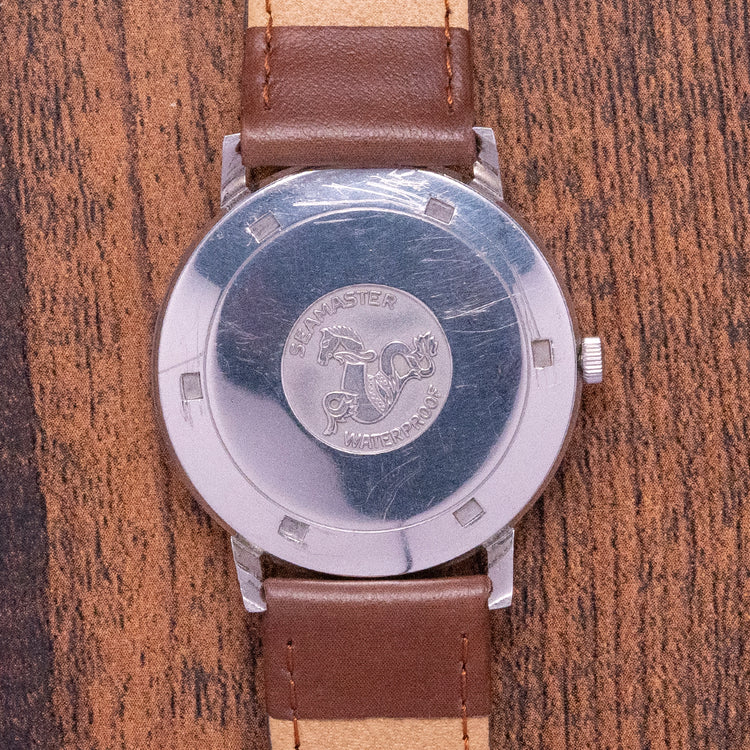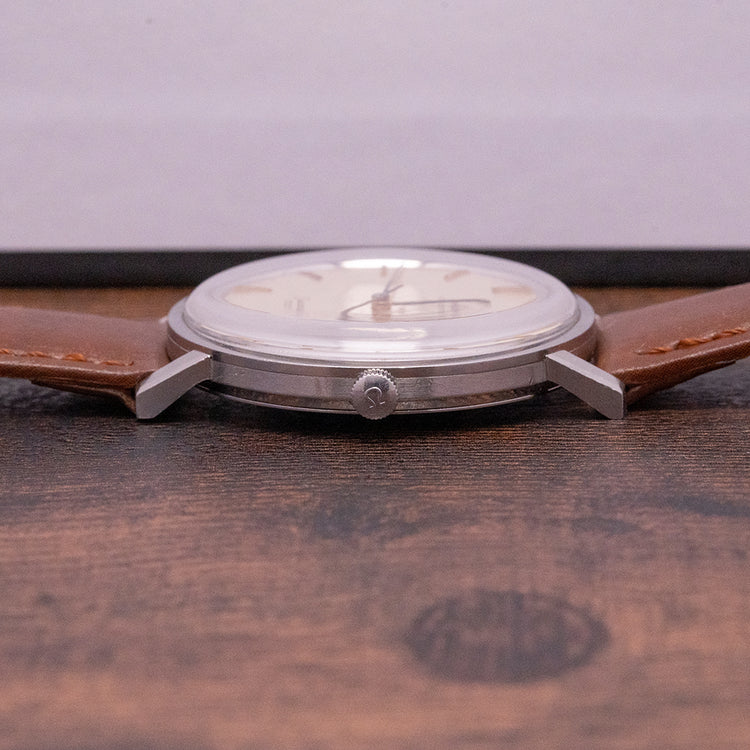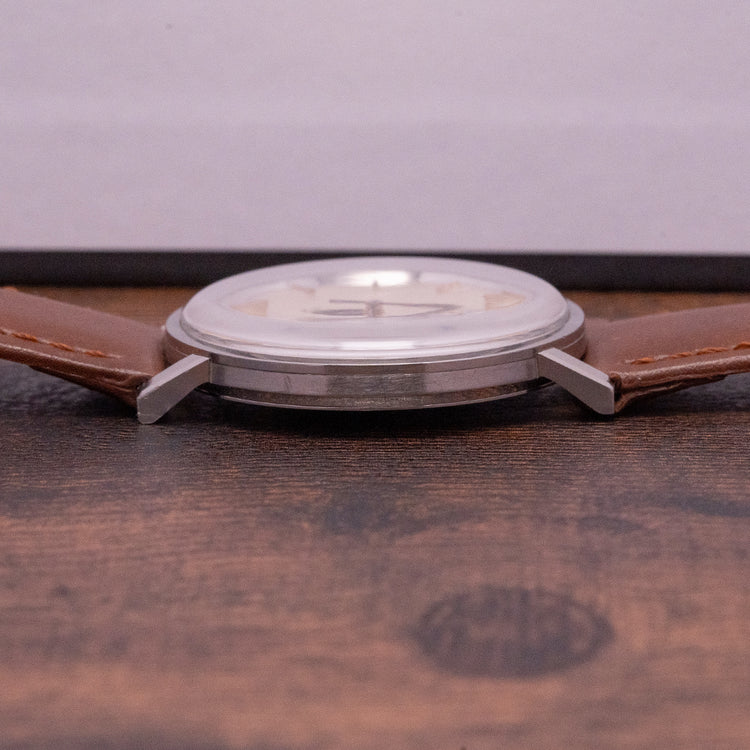More Information
Description
More
Less
The Watch
Here we have a 1970 Omega Seamaster De Ville 165.008 Box & Papers Set with a curvaceous 34mm stainless steel that curves over your wrist with straight-angled flat-ended lugs. The Seamaster was first introduced in 1948 to celebrate Omega’s 100th Anniversary, it was an immediate success and is Omega’s longest-running model. Based on the waterproof designs used during World War 2, it was improved upon with the addition of an “O” ring gasket which improved its water resistance. Omega’s first diving record came in 1955 when diver Gordon McLean reached a depth of 62.5 metres (205 ft) in Australia, the engineers were so confident of the durability that they strapped one to the outside of an aircraft that flew over the North Pole in 1956. A lug-to-lug length of 38.5mm and a case thickness of just 7mm ensure a comfortable fit on your wrist, on the right side, is a signed crown, and polished and brushed surfaces transition with crisp lines. A smooth polished bezel holds the domed crystal above the silver dial with slender chamfered applied double and singular baton indexes infilled in black marking the hours, slim black sword hands complemented by a tapered sweeping centre seconds hand complete the attractive dial. At 12 o'clock we have the Omega motif, and “Automatic” printed underneath, the text is precisely printed at 6 o’clock with "Seamaster Deville". On the case back we have the embossed Hippocampus in the centre that represents Neptune the God of the sea, it was conceived by Pierre Borie after seeing a picture of Neptune riding a chariot pulled by seahorses, it is the reason why the seahorses are wearing a bridle, first seen on the Seamaster in 1958. Inside an automatic Omega Cal. 771, 24 jewels, beating at 19,800 beats per hour, an incredibly thin calibre for the time. The watch comes paired with an 18mm leather strap, and the watch comes with its Omega presentation box and paperwork including the original receipt, insurance certificate and service receipt from 1972.
Points of Mention
This watch is sold with its original Omega presentation box (the hinges are broken on the box, very common for this age) and paperwork including the original receipt, insurance certificate and service receipt from 1972. The watch comes paired with a nice-fitting 18mm leather strap. The watch is from August 1970 and is sold in worn vintage condition, but is in overall fair vintage condition with an even patina across the dial, as you can see from the photographs. The watch comes with our 12-Months NON-Waterproof Warranty.
For more photos see here - https://drive.google.com/drive/folders/1DukRTy1L9RWg4ZyhyNTbHs4twT08rz5y?usp=drive_link
4K YouTube video, skip to 25:07 - https://youtu.be/n9GdZ-MlnLA
Personal Note
Today we understand the importance of keeping our box and paperwork together with our watch, but in 1970 that definitely wasn't an important thing to do and I've heard stories of people regularly not taking their boxes with them when they'd purchase a watch. The fact this incredible Seamaster De Ville comes with its box, paperwork, purchase receipt, insurance receipt and a service receipt from 1972 shows this was well looked after and a treasured possession. I love buying watches like this as I have the opportunity to get them ready to be enjoyed like that again and likely become someone else's treasured possession!
Specification
Lugs : 18mm
Condition : Pre-Owned
Box & Papers : Box & Papers
Case Material : Stainless Steel
Warranty : 12-Months NON-Waterproof Warranty
The Brand
Formerly known as the La Generale Watch Co. it was founded by Louis Brandt in La Chaux-de-Fonds in 1848. When he passed away in 1879, his sons quickly stepped in to carry on their father’s vision. In 1880 they moved to 96 Rue Jakob-Stampfli where they remain today. In 1885, the brothers released their first mass-produced calibre, the Labrador, Later in 1892, they developed the first minute-repeating timepiece. In 1903 they renamed the company Omega until 1982 when they officially changed their name to Omega SA. During WW1 Omega watches were used as official timekeepers for the Royal Flying Corps and the US Army. In 1930, Omega and Tissot merged together to form Société Suisse pour l'Industrie Horlogère (SSIH) In 1931, another group was formed - Allgemeine Schweizerische Uhrenindustrie AG (ASUAG). Where SSIH was primarily French-speaking, ASUAG was founded by the more German-speaking members of the Swiss watch industry. In 1948 they introduced the first edition of one of its most symbolic watches: the Seamaster. Omega first introduced the Constellation in 1952. At the time it was Omega's flagship timepiece. The first models had a Cal. 354 bumper movement in them. Later in 1955, Omega introduced the Automatic Cal. 50x, followed in 1959 by the Cal.55x (no date) and 56x (date) versions. Many of the Constellations came with pie-pan dials, diamond indexes, and fancy lug configurations. All the gold Constellations of that time have the Observatory of Geneva's hand engraved on the back. The stainless steel and stainless steel/gold versions had a gold medallion on the back with the Observatory of Geneva. The eight stars above the Observatory stand for the many exploits of Omega in the world Chronometer competition. Celebrating the fact that all Constellations are Chronometer Certified. In 1962, Omega made history when astronaut Wally Schirra wore a Speedmaster on his Mercury Sigma 7 Mission, making it the first Omega watch to enter space. After stringent tests, NASA used Omega for all their Apollo missions including the 1969 Moon landing of Apollo 11. Today Omega is still an astronaut's first choice of timepiece. In 1969, President Nixon famously turned down the opportunity to be gifted the first-ever all-gold Speedmaster Professional Deluxe because he deemed it to be “too valuable.” In response to the ever-growing threat of electronic watches to the manufacturers of mechanical watches, Omega in collaboration with Swiss brands such as Rolex and Patek Philippe formed Centre Electronique Horloger (CEH). Prototypes began in 1967 with production starting in 1968. Then In 1972, Omega introduced the reference, 198.030, which included the Omega calibre 1250, a ‘tuning-fork electronic movement which was made under licence from Bulova. Later we saw a merger of SSIH and ASUAG into SMH, or Société de Microélectronique et d’Horlogerie. This merger took place in 1983. In 1992, the company acquired Blancpain, and in 1998 they officially rebranded themselves from SMH to the Swatch Group. Then, in 1999, they purchased and integrated Breguet into the group.
Points of Mention
More
Less
Personal Note
More
Less
Specification
More
Less
Movement : Automatic Omega Cal. 711
Age : August 1970
Year : 1970
Case Size : 34mm
Case Thickness : 7 mm
Lug to Lug : 38.5mm
Lugs : 18mm
Condition : Pre-Owned
Case Material : Stainless Steel
Warranty : 12-Months NON-Waterproof Warranty
The wrist model's wrist size is 7inch
About Omega
More
Less
Description
The Watch
Here we have a 1970 Omega Seamaster De Ville 165.008 Box & Papers Set with a curvaceous 34mm stainless steel that curves over your wrist with straight-angled flat-ended lugs. The Seamaster was first introduced in 1948 to celebrate Omega’s 100th Anniversary, it was an immediate success and is Omega’s longest-running model. Based on the waterproof designs used during World War 2, it was improved upon with the addition of an “O” ring gasket which improved its water resistance. Omega’s first diving record came in 1955 when diver Gordon McLean reached a depth of 62.5 metres (205 ft) in Australia, the engineers were so confident of the durability that they strapped one to the outside of an aircraft that flew over the North Pole in 1956. A lug-to-lug length of 38.5mm and a case thickness of just 7mm ensure a comfortable fit on your wrist, on the right side, is a signed crown, and polished and brushed surfaces transition with crisp lines. A smooth polished bezel holds the domed crystal above the silver dial with slender chamfered applied double and singular baton indexes infilled in black marking the hours, slim black sword hands complemented by a tapered sweeping centre seconds hand complete the attractive dial. At 12 o'clock we have the Omega motif, and “Automatic” printed underneath, the text is precisely printed at 6 o’clock with "Seamaster Deville". On the case back we have the embossed Hippocampus in the centre that represents Neptune the God of the sea, it was conceived by Pierre Borie after seeing a picture of Neptune riding a chariot pulled by seahorses, it is the reason why the seahorses are wearing a bridle, first seen on the Seamaster in 1958. Inside an automatic Omega Cal. 771, 24 jewels, beating at 19,800 beats per hour, an incredibly thin calibre for the time. The watch comes paired with an 18mm leather strap, and the watch comes with its Omega presentation box and paperwork including the original receipt, insurance certificate and service receipt from 1972.
Points of Mention
This watch is sold with its original Omega presentation box (the hinges are broken on the box, very common for this age) and paperwork including the original receipt, insurance certificate and service receipt from 1972. The watch comes paired with a nice-fitting 18mm leather strap. The watch is from August 1970 and is sold in worn vintage condition, but is in overall fair vintage condition with an even patina across the dial, as you can see from the photographs. The watch comes with our 12-Months NON-Waterproof Warranty.
For more photos see here - https://drive.google.com/drive/folders/1DukRTy1L9RWg4ZyhyNTbHs4twT08rz5y?usp=drive_link
4K YouTube video, skip to 25:07 - https://youtu.be/n9GdZ-MlnLA
Personal Note
Today we understand the importance of keeping our box and paperwork together with our watch, but in 1970 that definitely wasn't an important thing to do and I've heard stories of people regularly not taking their boxes with them when they'd purchase a watch. The fact this incredible Seamaster De Ville comes with its box, paperwork, purchase receipt, insurance receipt and a service receipt from 1972 shows this was well looked after and a treasured possession. I love buying watches like this as I have the opportunity to get them ready to be enjoyed like that again and likely become someone else's treasured possession!
Specification
Lugs : 18mm
Condition : Pre-Owned
Box & Papers : Box & Papers
Case Material : Stainless Steel
Warranty : 12-Months NON-Waterproof Warranty
The Brand
Formerly known as the La Generale Watch Co. it was founded by Louis Brandt in La Chaux-de-Fonds in 1848. When he passed away in 1879, his sons quickly stepped in to carry on their father’s vision. In 1880 they moved to 96 Rue Jakob-Stampfli where they remain today. In 1885, the brothers released their first mass-produced calibre, the Labrador, Later in 1892, they developed the first minute-repeating timepiece. In 1903 they renamed the company Omega until 1982 when they officially changed their name to Omega SA. During WW1 Omega watches were used as official timekeepers for the Royal Flying Corps and the US Army. In 1930, Omega and Tissot merged together to form Société Suisse pour l'Industrie Horlogère (SSIH) In 1931, another group was formed - Allgemeine Schweizerische Uhrenindustrie AG (ASUAG). Where SSIH was primarily French-speaking, ASUAG was founded by the more German-speaking members of the Swiss watch industry. In 1948 they introduced the first edition of one of its most symbolic watches: the Seamaster. Omega first introduced the Constellation in 1952. At the time it was Omega's flagship timepiece. The first models had a Cal. 354 bumper movement in them. Later in 1955, Omega introduced the Automatic Cal. 50x, followed in 1959 by the Cal.55x (no date) and 56x (date) versions. Many of the Constellations came with pie-pan dials, diamond indexes, and fancy lug configurations. All the gold Constellations of that time have the Observatory of Geneva's hand engraved on the back. The stainless steel and stainless steel/gold versions had a gold medallion on the back with the Observatory of Geneva. The eight stars above the Observatory stand for the many exploits of Omega in the world Chronometer competition. Celebrating the fact that all Constellations are Chronometer Certified. In 1962, Omega made history when astronaut Wally Schirra wore a Speedmaster on his Mercury Sigma 7 Mission, making it the first Omega watch to enter space. After stringent tests, NASA used Omega for all their Apollo missions including the 1969 Moon landing of Apollo 11. Today Omega is still an astronaut's first choice of timepiece. In 1969, President Nixon famously turned down the opportunity to be gifted the first-ever all-gold Speedmaster Professional Deluxe because he deemed it to be “too valuable.” In response to the ever-growing threat of electronic watches to the manufacturers of mechanical watches, Omega in collaboration with Swiss brands such as Rolex and Patek Philippe formed Centre Electronique Horloger (CEH). Prototypes began in 1967 with production starting in 1968. Then In 1972, Omega introduced the reference, 198.030, which included the Omega calibre 1250, a ‘tuning-fork electronic movement which was made under licence from Bulova. Later we saw a merger of SSIH and ASUAG into SMH, or Société de Microélectronique et d’Horlogerie. This merger took place in 1983. In 1992, the company acquired Blancpain, and in 1998 they officially rebranded themselves from SMH to the Swatch Group. Then, in 1999, they purchased and integrated Breguet into the group.
Points of Mention
Personal Note
Specification
The Brand
Enquire or Book an Appointment
Would you like to discover further details about this watch, or perhaps arrange an appointment to view and try it on? Complete this form and a member of our team will get back to you shortly.
You May Also Like




















